In this guitar lesson you’re going to practice sweep picking arpeggios by looking different major and minor arpeggio shapes.
Note that this lesson doesn’t go in-depth on how to sweep pick. It just presents the arpeggios and their sweep picking shapes.
Table of Contents
Sweep picking arpeggios made simple
As long as you know your 5 Major CAGED shapes, and your 3 Minor CAGED shapes, then sweep picking arpeggios will be a piece of cake.
CAGED shapes are the open position chords that most guitar players learn as beginners. If you don’t know those shapes, then here are their individual lessons.
- Learn the C chord
- Learn the A chord
- Learn the G chord
- Learn the E chord
- Learn the D chord
- Learn the A minor chord
- Learn the D minor chord
- Learn the E minor chord
What is a sweep picking arpeggio?
If you’re new to sweep picking and arpeggios, you might be wondering what a sweep picking arpeggio is.
A sweep picking arpeggio, or arpeggio sweep, is a 1 note-per-string arpeggio shape played sweeping downwards and upwards with the picking hand.
When you get to the highest string in the arpeggio shape, the sweep-picking motion turns around, moving from sweeping downwards to sweeping back up.
If you want an in-depth explanation on arpeggios as a whole, then check out this guitar lesson.
Not all arpeggios are playing using sweep picking
Some guitar players tend to wonder or imply that sweep picking and arpeggios are the same thing.
Sweep picking is not the same thing as arpeggios, and not all arpeggios are played using the sweep picking technique. Arpeggios are just chords broken down into individual notes, and a sweep is one of many potential techniques for playing an arpeggio.
Sweep picking arpeggios shapes
These are the most common sweep
Here’s a quick legend:
- Numbers in parentheses such as (1), (3), and (5) refer to the intervals in the arpeggio
C shape
This first arpeggio used the C major shape.
In this diagram the root note is G, making it a G major arpeggio using a C shape.
Practice this shape and every other arpeggio shape using different root notes.
Left-hand finger pattern
- Pinky on the A string
- Ring finger on the D string
- Index finger on the G string
- Middle finger on the B string
- Index finger on the high E string (The “3” interval)
- Pinky on the high E string (The “5” interval)
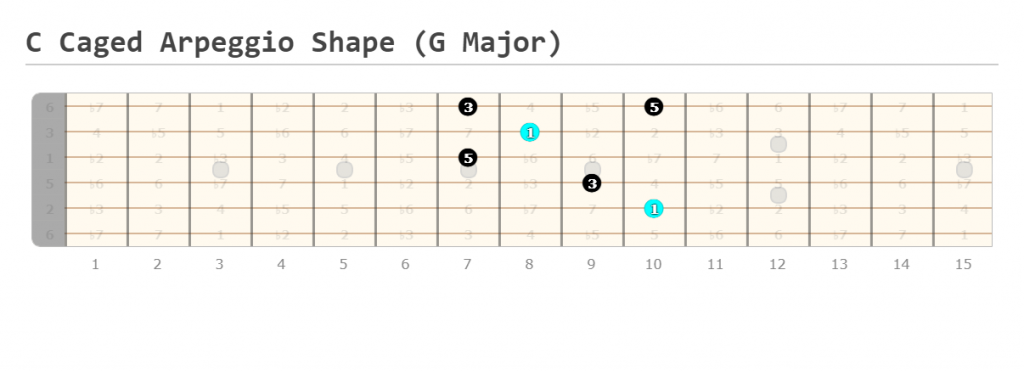
A shape
This 2nd arpeggio used the A major shape.
In this diagram the root note is G again, making it a G major arpeggio using the A shape.
Once again, practice this shape using different root notes.
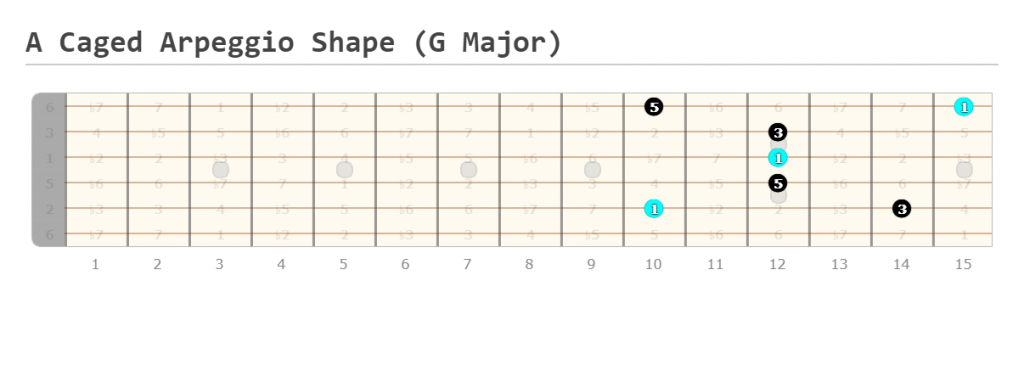
Left-hand finger pattern
- Index finger on the A string (1)
- Pinky on the A string (3)
- Middle finger will bar the notes, one at a time, on the D,G, and B strings.
- Index finger on the high E string (5)
- Pinky finger on the high E string (1)
G shape
This 3rd arpeggio used the G major shape.
In this diagram the root note is G again, making it a G major arpeggio using the G shape! Yep, the root note actually matches the shape this time.
Once again, don’t forget to practice this shape using different root notes!
It’s arguably the least common major shape for sweep picking because the A shape is an easier alternative that targets the same notes.

Left-hand finger pattern
- Pinky on the E string
- Ring finger on the A string
- Index finger barring the D,B, and B strings, played one note at a time
- Pinky finger playing the B string (5) and high E string (1)
E shape
This 4th arpeggio uses the E major shape.
In this diagram the root note is G again, making it a G major arpeggio using the E shape.
The E CAGED arpeggio shape is kind of hard to play, but it’s the most common 6-string major arpeggio shape, so it’s useful to learn.
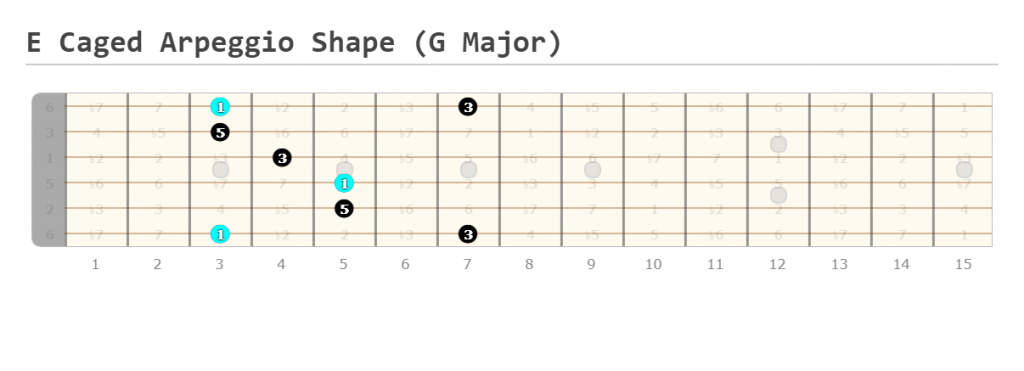
Left-hand finger pattern
- Index finger on the low E string (1)
- Pinky on the low E string (3)
- Ring finger barring the notes on the A and D strings (5) and (1)
- Middle finger on the G string (3)
- Index finger barring the high B and high E strings (5) and (1)
- Pinky on the high E string (3)
D shape
This 5th and final major arpeggio uses the D major shape.
In this diagram the root note is G again, making it a G major arpeggio using the D shape.
The D CAGED arpeggio shape is the easiest to play and remember, which makes it a fun one to learn!
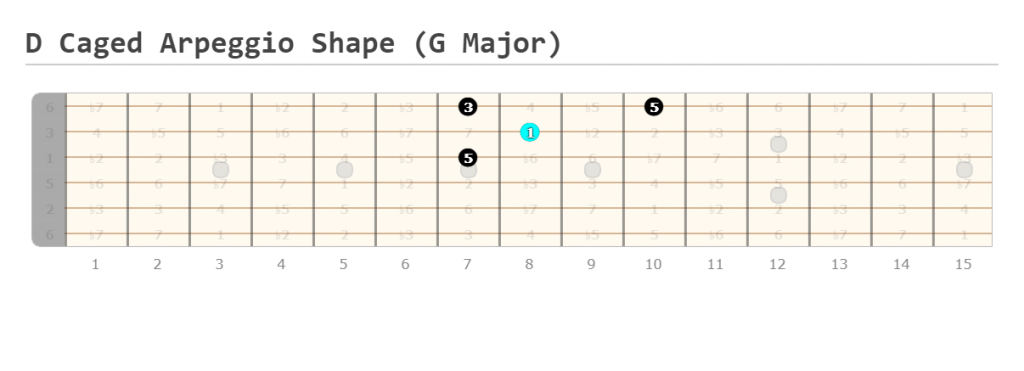
Left-hand finger pattern
- Index finger on the G string
- Middle finger on the B string
- Index finger on the high E string (3)
- Pinky on the high E string (5)
A Minor shape
When looking at the minor shapes, make sure you compare them to their major shape counterparts, as it will help you understand the difference between major and minor harmony.
This is the A minor shape using G as the root note, resulting in a G minor arpeggio.
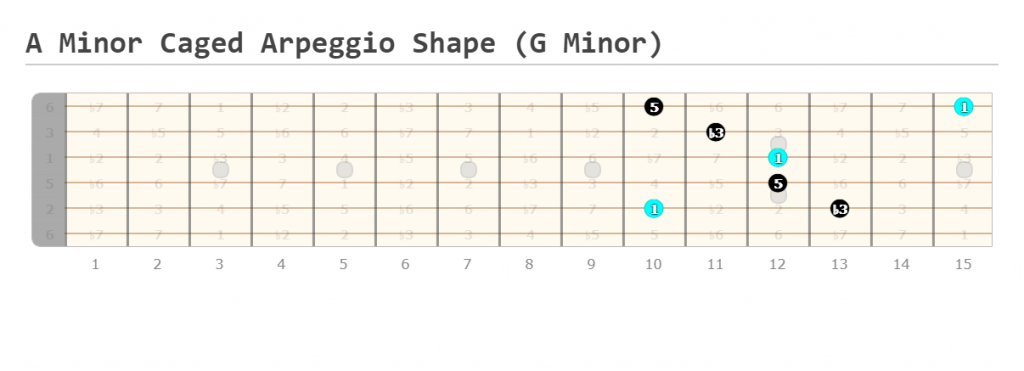
Left-hand finger pattern
- Index finger on the A string
- Pinky on the A string (b3)
- Ring finger barring the D and G strings, (5) and (1)
- Middle finger on the B string
- Index finger on the high E string (5)
- Pinky on the high E string (1)
D Minor shape
Here is the D minor shape using G as the root note, resulting in another G minor arpeggio.
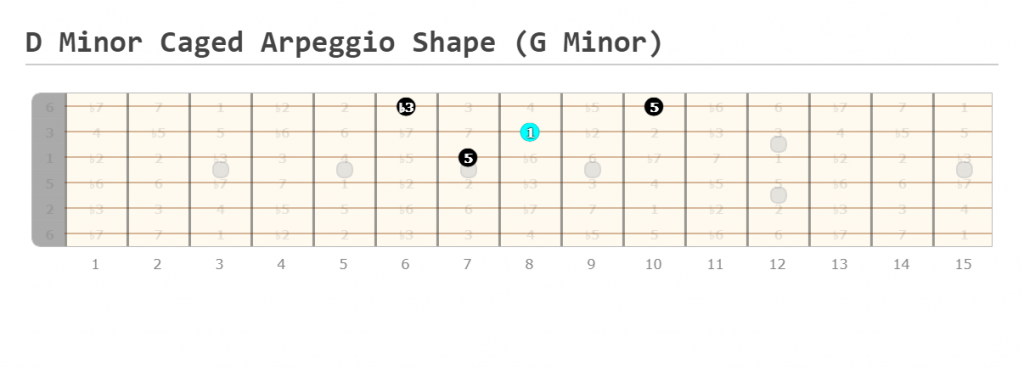
Left-hand finger pattern
- Middle finger on the G string
- Ring finger on the B string
- Index finger on the high E string (b3)
- Pinky on the high E string (5)
E Minor shape
Lastly, this is the E minor shape using G as the root note, resulting in the final G minor arpeggio.

Left-hand finger pattern
- Index finger on the low E string
- Pinky on the low E string (b3)
- Ring finger barring the A and D strings, (5) and (1)
- Index finger barring the G, B, and high E strings (b3), (5), (1)
- Pinky finger playing the high E string (b3)
1 4 5 sweep picking arpeggios
Here are 3 arpeggio shapes used to create a 1-4-5 in G Major. This is just one way you could sweep pick a 1-4-5 chord progression.
For practice, I suggest taking the other major and minor arpeggio shapes and creating your own sweep picked chord progressions.
As for this example, you’ll end up with the arpeggio progression:
G Major – C Major – D Major
1-4-5 sweep picking arpeggios in G major
Follow the left-hand finger structures you learned above in order to play each of these shapes.
Here’s the E major shape using G as the root note.

Here’s the C major shape using D as the root note.

Here’s the A major shape using C as the root note.

Sweep picking arpeggios conclusion
There you have it, the 5 major sweep picking arpeggios, and the 3 minor shapes.
From here I strongly suggest you move into understanding the broader technique that takes sweeping to the next level: economy picking.
Until next time, keep practicing!


